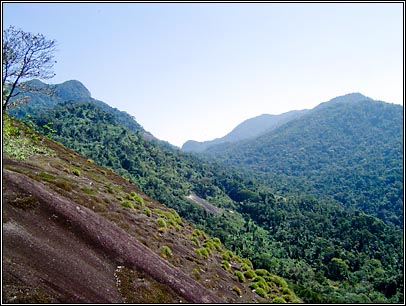 |
FLORISTICS AND CONSERVATION OF ORCHIDACEAE AT NATURAL RESERVE IN RIO DE JANEIRO Eduardo
Martins Saddi & |
| The
Work The authors have worked in a Reserve in the district of Rio de Janeiro which name and coordinates are not giving for conservation reason as some species found in the area are endangered. From February 2003 to February 2004, they made monthly 3-day trips to the study area. The work consisted of surveying the Floristic and conserving the Orchidaceae in an area which represents a valuable remnant of the Atlantic Pluvial Forest. |
| The Place |
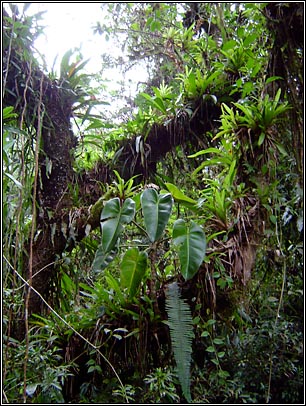 |
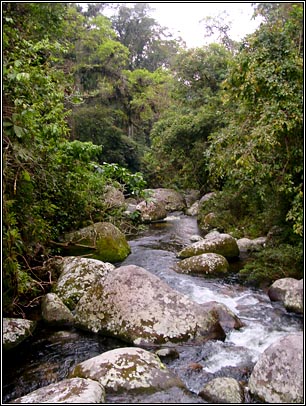 |
This
reserve, with 20–1050 m elevation in an
area of 1305 ha, lies within the Rio Grande watershed,
and this river runs full course through a deep
valley, descending sharply from source to mouth
over steep terrain with a 37º slope (Vidal
1995). In contrast to other surveys of the orchid
family in the State of Rio de Janeiro, the Reserve
is the smallest area but the richest in orchid
species makes it an important forest remainder
in the State. The region has a warm climate with
a mean annual temperature of 22ºC, rainfall
of 1200– 2500 mm, and 11–12 months
with 800 mm of hydric excess. Ten main trails
cut through the reserve, which is considerably
influenced by human activities, especially from
ca. 20–420 m elevation, where bananas once
were planted. Above 450 m, the forest becomes
more dense and humid, with large trees forming
a canopy ca. 20–30 m tall (Quinet 2002). |
| The Orchidaceae family |
The
orchid family is the most representative one among
the monocotyledons, representing 48% of the total
species in this group. Two subfamilies, 43 genera,
and 88 species of orchids have been identified
in the Reserve. The most representative genera
are Pleurothallis (13 spp.) and Epidendrum
(9 spp.) |
MATERIAL
AND METHODS Floristic As part of their research, the authors revised the list of Orchidaceae species compiled by botanists from the Angiosperm Laboratory, Santa Ursula University (USU), who have been collecting in the area since 1996 as part of this Reserve Floristic Project. They made botanical collections along the trails and in the surroundings, giving preference to flowering and fruiting material. They recorded data on morphology, population numbers, phenology, life forms, substrate type, and altitude. Flowers were fixed in 70% alcohol with 10% glycerin for later analysis (Pinheiro 1999). Specimens were pressed and dried according to standard procedures (Fidalgo & Bononi 1984) and deposited in the Santa Ursula University Herbarium (RUSU). Whenever possible, duplicates were sent to the Rio de Janeiro Federal University Herbarium (RFA) (abbreviations follow Holmgren et al. 1990). Data on major plant groups in the study area are presented. Taxonomic studies were based on the literature as well as consultations with specialists and with the collections of the Research Institute, Rio de Janeiro Botanical Garden. The classification system follows Dressler (1993). |
RESULTS
AND DISCUSSION The orchid species list compiled by the team of this Reserve Floristic Project originally had 29 species and 22 genera of Orchidaceae. After one year of collecting in the area, the list grew to 88 species in 43 genera (TABLE 1). Of this total, 59 species were collected solely by the senior author, 17 by the project team, and 12 by both . Orchidaceae make up 48% of the monocots found in this Reserve, followed by Araceae (10%), Marantaceae (9%), Commelinaceae (8%), Bromeliaceae (8%), and other families (17%). The Orchidaceae consists of five subfamilies (Dressler 1993), three of which have representatives in Brazil. The orchid species at this Reserve belong to two subfamilies—Epidendroideae and Spiranthoideae—which are mostly epiphytes or terrestrial species, respectively. Of the 43 genera, the most species-rich are Pleurothallis (13 spp.), Epidendrum (9 spp.), Maxillaria (6 spp.), Beadlea (5 spp.), Octomeria (5 spp.), Oncidium (4 spp.), Bifrenaria (2 spp.), Dichaea (2 spp.), Eltroplectris (2 spp.), Eurystyles (2 spp.), Gomesa (2 spp.), Promenaea (2 spp.), Prosthechea (2 spp.), and Stelis (2 spp.); and the other genera have one species each . Regarding life form, 61 of the 88 species analyzed are strictly epiphytes, 20 are strictly terrestrial, and 7 are epiphytes and terrestrial. The terrestrial species are classified as terrestrial (12 spp.), rupicolous (4 spp.), saxicolous (3 spp.), and saprophytes (1 sp.). Of the 61 strictly epiphytic species, 57 belong to the subfamily Epidendroideae. Although most of the genera in this subfamily have only epiphytic species, some genera, such as Malaxis and Oeceoclades, include terrestrial species (Fraga 2000). Of the 20 terrestrial species, 12 belong to the Spiranthoideae, which represents the life form most commonly found in this subfamily. All seven species that have both terrestrial and epiphytic life forms are found on the banks of the Rio Grande. Two of these species are found in other habitats (forest interior or rocky outcrops), where they always occur as one life form. For instance, Epidendrum secundum Jacq. is a terrestrial plant growing on rocky outcrops, and Isochilus linearis (Jacq.) R. Br. is an epiphyte in the forest. |
TABLE
1 |
Orchid
checklist of this natural reserve RJ, Brazil.
|
Orchid
species |
Orchid
species |
| Beadlea
bicolor (Ker- Gawl.) Garay Beadlea elata (Sw.) Small Beadlea elegans (Hoehne) Garay Beadlea itatiaiensis (Krzl.) Garay Beadlea aff. longibracteata (Barb. Rodr.) Garay Bifrenaria harrisoniae (Hook) Rchb.f. Bifrenaria inodora Lindl. Bulbophyllum micranthum Barb. Rodr. Campylocentrum sellowii (Rchb. f.) Rolfe Cattleya forbesii Lindl. Cirrhaea saccata Lindl. Cochleanthes sp. Constantia rupestris Barb. Rodr. Cyrtopodium polyphyllum (Vell.) Pabst ex F.Barros Dichaea cogniauxiana Schltr. Dichaea pendula (Aubl.) Cogn. Dipteranthus pellucidus (Rchb.) Cogn. Elleanthus sp. Eltroplectris janeirensis (Porto & Brade) Pabst Eltroplectris triloba (Lindl.) Pabst Encyclia patens Hook. Epidendrum armeniacum Lindl. Epidendrum campaccii Hágsater & L. Sánchez Epidendrum filicaule Lindl. Epidendrum geniculatum Herb. Ham. Ex Hook.f. Epidendrum ramosum Jacq. Epidendrum rigidum Jacq. Epidendrum secundum Jacq. Epidendrum vesicatum Lindl. Epidendrum sp. Erythrodes arietina Ames Eurystyles cogniauxii (Krlz.) Pabst Eurystyles cotyledon Wawra Galeandra beyrichii Rchb. f. Gomesa crispa Klotzch ex Rchb. f. Gomesa planifolia Klotzch ex Rchb. f. Gongora bufonia Lindl. Hapalorchis lineata Schltr. Isochilus linearis (Jacq.) R. Br. Laelia crispa (Lindl.) Rchb. f. Lankesterella ceracifolia (Barb. Rodr.) Mansf. Leptotes bicolor Lindl. Malaxis excavata Kuntze Maxillaria brasiliensis Brieger & Bicalho Maxillaria marginata (Lindl.) Fenzl. Maxillaria parviflora (Poepp. & Endl.) |
Maxillaria
picta Hook. Maxillaria rufescens Lindl. Maxillaria sp. 1 Mesadenella cuspidata (Lindl.) Garay Octomeria albopurpurea Barb. Rodr. Octomeria juncifolia Barb. Rodr. Octomeria oxIchella Barb. Rodr. Octomeria tricolor Rchb.f. Octomeria sp. Oeceoclades maculata (Lindl.) Lindl. Oncidium cornigerum Lindl. Oncidium fimbriatum Lindl. Oncidium flexuosum Sims. Oncidium longipes Lindl. Pelexia novofriburgensis (Rchb. f.) Garay Phymatidium tillandsoides Barb. Rodr. (Phymatdium falcifolium Lindl.) Pleurothallis aphtosa Lindl. Pleurothallis bidentula Barb. Rodr. Pleurothallis compressiflora Barb. Rodr. (Pleurothallis auriculata Lindl.) Pleurothallis granulosa (Barb. Rodr.) Pleurothallis grobyi Bateman ex. Lindl. Pleurothallis hypnicola Lindl. Pleurothallis lineolata (Barb. Rodr.) Pleurothallis rubens Lindl. Pleurothallis saundersiana Rchb.f. Pleurothallis aff. trifida Lindl. Pleurothallis sp. 1 Pleurothallis sp. 2 Pleurothallis sp. 3 Polystachya concreta (Jacq.) Garay Prescottia plantaginea Lindl. Promenaea ovatiloba Cogn. Promenaea paulensis Schltr. Prosthechea pygmaea (Hook) W. E. Prosthechea vespa (Vell.) W. E. Sacoila lanceolata (Aubl.) Garay Sarcoglottis fasciculata (Vell.) Schltr. Stanhopea guttulata Lindl. Stelis megantha Barb. Rodr. Stelis aff. modesta Barb. Rodr. Tetragamestus modestus Rchb.f. (Scaphyglottis modesta Schltr.) Wullschlaegelia aphylla Rchb. f. Xylobium variegatum (Ruiz & Pav.) |
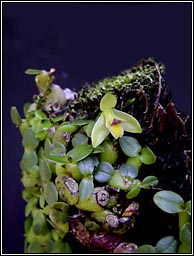 Constantia rupestris |
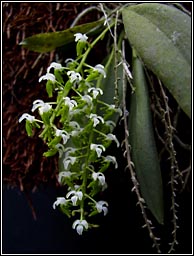
Diptheranthus pellucidus |
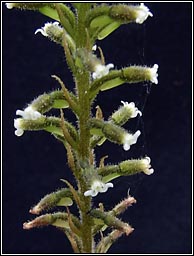
Erythrodes arietina |
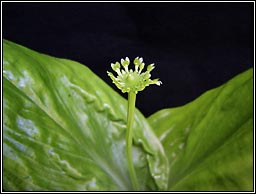 Malaxis
excavata
Malaxis
excavata |
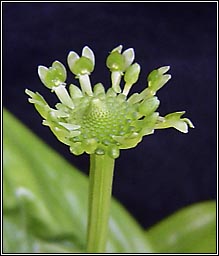
Malaxis excavata - detalhe |
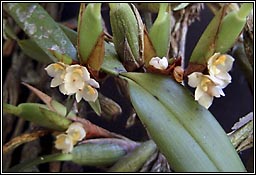 Maxillaria parviflora
Maxillaria parviflora |
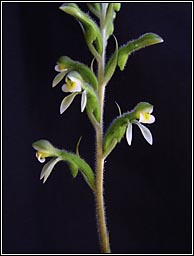
Pelexia novofriburguensis |
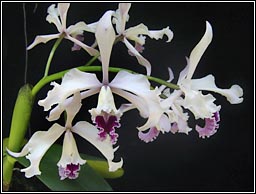 Laelia crispa
Laelia crispa |
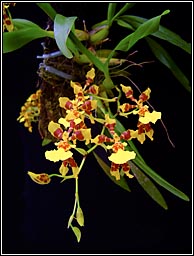
Oncidium longipes |
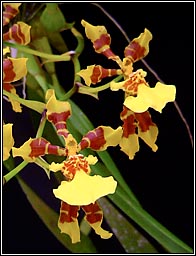
Oncidium longipes - detalhe |
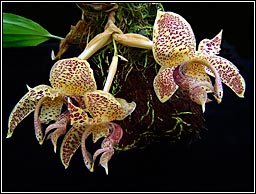 Stanhopea guttulata
Stanhopea guttulata |
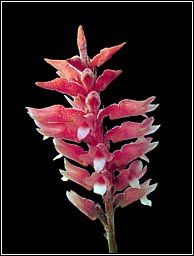
Sacoila lanceolata |
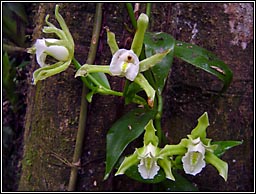 Vanilla angustipetala
Vanilla angustipetala |
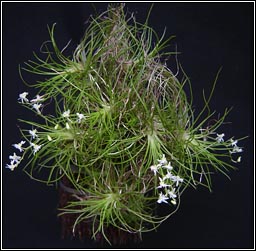 Phymathydium tillandsioides
Phymathydium tillandsioides |
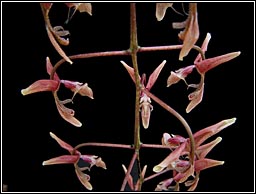 Gongora bufonia |
|
Conservation
Status |
TABLE
2. |
Conservation
status of 24 species from the checklist of this natural Reserve per locality |
| species | RS |
PR |
RJ |
ES |
JBRJ Greenhouse |
| Beadlea elegans | VU |
||||
| Bifrenaria harrisoniae | EN |
EN |
|||
| Bifrenaria inodora | EN |
|
X |
||
| Cattleya forbesii | EN |
X |
|||
| Cirrhaea saccata | EN |
X |
|||
| Cyrtopodium polyphyllum | EN |
LR |
X |
||
| Eltroplectris triloba | LR |
||||
| Epidendrum rigidum | VU |
||||
| Epidendrum secundum | DD |
X |
|||
| Erythrodes arietina | EN |
X |
|||
| Gongora bufonia | RARE |
X |
|||
| Hapalorchis lineata | EN |
||||
| Leptotes bicolor | EN |
X |
|||
| Mesadenella cuspidata | VU |
X |
|||
| Oeceoclades maculata | LR |
||||
| Pleurothallis auriculata | EN |
X |
|||
| Pleurothallis grobyi | VU |
X |
|||
| Pleurothallis saundersiana | VU |
X |
|||
| Polystachya concreta | LR |
X |
|||
| Prescottia plantaginea | LR |
X |
|||
| Prosthechea pygmaea | VU |
||||
| Sacoila lanceolata | DD |
X |
|||
| Sarcoglottis fasciculata | LR |
X |
|||
| Wullschlaegelia aphyla | EN |
In
and Ex-situ Conservation Conserving natural habitats will protect many species, including orchids; but some species require more specific measures (IUCN 1996). The conservation of species may depend on both in-situ and ex-situ strategies. In-situ conservation takes place in conservation units, while ex-situ conservation depends on seed banks, botanical garden collections, nurseries with testimonial seedlings, cryopreservation, and in-vitro collections. These methods complement one another, because not all wild species and their populations can be maintained in natural reserves or environmental protection areas, which often have been reduced to small areas by urban sprawl and expanding agricultural frontiers (Cavalcanti & Walter 1998). Ex-situ Conservation - Live collections Live collections are essential for conservation, especially regarding propagation and reintroduction of orchid species. These plants produce thousands of seeds, and there are well-known techniques for their symbiotic and asymbiotic germination. Such activities must be closely followed by studies of geographic distribution, habitat specificity, and population size of each species (IUCN 1996). The orchid collection maintained by the Research Institute of the Rio de Janeiro Botanical Garden (JBRJ) aims to scientifically conserve and propagate genetic material from the Brazilian Flora, thus contributing to the ex-situ conservation of endangered species. As a result, the vegetative specimens are deposited in the Live-Plant Collection of this institution. Today, it contains 124 specimens belonging to 38 genera and 52 species. Some 72 of these plants have not yet flowered and have only been identified to the genus level. Of the 88 species that make up the list of orchids at the reserve, 45 are under cultivation (51% of the total number of species). Thirteen species (15% of the total) have not yet flowered and have only been identified to the genus level. Besides adding a significant number of taxa to the list, the live collection has allowed us to observe the development and morphological aspects of vegetative and reproductive organs of the species, which will contribute to future studies. Educational programs related to orchid collections are needed, especially in the tropics, because otherwise conservation efforts will not bear fruit (Davis et al. 1986). Eduardo Saddi points out the importance of every alive collection to be referencied. Since the plants have been already collected, it is necessary that this agression to the nature has, at least, an utility. It is necessary that the collector creates a referencied data bank with registers of all possible information about the collection in order to, in a near or next future, the collection becomes useful for conservationist aims. A non-referencied collection is useless for the science. If the data are only known by the collector, the collection loses its scientific means because in case of forgetfulness or his decease, all information are lost. ACKNOWLEDGMENTS The authors thanked Marta Moraes and Melissa Bocayuva for their support with the live collection at JBRJ; Dorothy S.D. de Araujo for translation of the manuscript; Pablo V. Prieto and Carlo A. Zaldini for their assistance in the field; Carl Luer and the IOCC II ‘‘team’’ for their hospitality at the Marie Selby Botanical Gardens and the Brazilian Scientific Academy for the grants. Note of the editor - New occurence to the state of Rio de Janeiro. Stanhopea guttulata is a new occurrence for the state of Rio de Janeiro, as well Vanilla angustipetala and Maxillaria parviflora. Former registers: Stanhopea guttulata - Espírito Santo Vanilla angustipetala - Paraná and Santa Catarina Maxillaria parviflora - from north, northeast and center-west regions |
LITERATURE
CITED
(in the original work) Barros, F. 1990. Diversidade taxonômica e distribuição das Orchidaceae brasileiras. Acta. Bot. Bras. 4(1): 177–187. . 1996. Notas Taxonômicas para as espécies brasileiras dos gêneros Epidendrum, Platystele, Pleurothallis e Scaphyglottis (Orchidaceae). Acta Bot. Bras. 10(1): 139–151. BDT. 2004. Base de Dados Tropical. Published on the Internet at http://www.bdt.org.br accessed 01 March 2004; 10:00 GMT. Benzing, D.H. 1981. Bark surfaces and the origin and maintenance of diversity among angiosperm epiphytes: a hypothesis. Selbyana 5: 248–255. . 1987. Vascular epiphytism: taxonomic participation and adaptative diversity. Ann. Mo. Bot. Gard. 74: 183–204. Brade, A.C. 1951. O gênero Habenaria (Orchidaceae) no Itatiaia. Rodriguesia 14(26): 7–20. Cavalcanti, T.B. and B.M.T. Walter. 1998. Coleta e conservação de recursos genéicos no Brasil. Pp. 69–87 in V.S. Fonseca, I.M. Silva, and C.F.C. Sá, eds. Etnobotânica. Bases para conservação. EDUR: UFRRJ, Rio de Janeiro. Costa, M.L.N., M. Moraes, R. Pizarro Drummond, G. Cattan and M. Bocayuva. 2002. Revitalização da Coleção de Orchidaceae do Jardim Botânico do Rio de Janeiro. P. 413 in Resumos do 53o. Congresso Nacional de Botânica e 25a Reunião Nordestina de Botânica. João Pessoa. Davis, S.D., S.J.M. Droop, P. Gregerson, C.J. Leon, J. Lamlein Villa-Lobos, H. Singe and J. Zantouska. 1986. Plants in Danger: What Do We Know? IUCN-WWF, Cambridge, UK. Dressler, R.L. 1981. The Orchids: Natural History and Classification. Harvard University Press, Cambridge, Massachussetts. . 1993. Phylogeny and Classification of the Orchid Family. Cambridge University Press, Cambridge, UK. Fagnani, M.P.K. and C.I.S. Siqueira. 1998. Orquídeas da da restinga de Massambaba. Pp. 293–296 in Atas da 15th Conferência Mundial de Orquídeas. Naturalia Publications, Transfère S.A., Turriers, France. Fidalgo, O. and V.L.R. Bononi. 1984. Técnicas de Coleta e Herborização de Material Botânico. Manual No. 4. Secretaria de Agricultura e Abastecimento. Instituto de Botânica, São Paulo. Fraga, C.N. ‘‘Ecologia, Fitogeografia e Conservação das Orchidaceas da Restinga do Estado do Espírito Santo.’’ M.S. diss., Universidade Federal do Rio de Janeiro, Rio de Janeiro, RJ, Brasil, 2000. Holmgren, P.K., N.H. Holmgren, and L.C. Barnet. 1990. Index Herbariorum, 8th ed. New York Botanical Garden, New York. IUCN. 1994. IUCN Red List Categories. IUCN Species Survival Commission. IUCN, Gland, Switzerland. . 1996. Orchids—Status Survey and Conservation Action Plan. IUCN, Gland, Switzerland, and Cambridge, UK. Marques, M.C.M. 1997. Mapeamento da Cobertura Vegetal e Listagem das Espécies Ocorrentes na Área de Proteção Ambiental de Cairuçu, Municipio de Parati, RJ, Rio de Janeiro Jardim Botânico, Rio de Janeiro. Mello, A.C.G. ‘‘Orchidaceae da Ilha de Cabo Frio, Município de Arraial do Cabo, RJ.’’ M.S diss., Universidade Federal do Rio de Janeiro Rio de Janeiro, RJ, Brasil, 2002. Miller, D. and R. Warren. 1994. Orchids of the High Mountain Atlantic Rain Forest in Southeastern Brazil. Salamandra Consultoria Editorial SA, Rio de Janeiro, Brazil. Pabst, G.F.J. and F. Dungs. 1975. Orchidaceae Brasiliensis. Germany, Hildeshein: Kurt Schmersow. Band I. Pinheiro, F.C. ‘‘Orquidaceae do Parque Estadual da Serra da Tiririca, Niterói, Rio de Janeiro.’’ M.S. diss., Universidade Federal do Rio de Janeiro, Rio de Janeiro, Rj, Brasil, 1999. Quinet, C.G.P. ‘‘Apocynaceae Juss. Na Reserva rio das Pedras, Município de Mangaratiba, Rio de Janeiro, Brasil.’’ M.S. diss., Universidade Federal do Rio de Janeiro, Rio de Janeiro, RJ, Brasil, 2002. Rivero, R.E. 2001. Targeting orchids and other epiphytes in a conservation education program in Costa Rica. Pp. 63–69 in W.E. Higgins and B.W. Walsh, eds. Orchid Conservation Proceedings: An International Conference on Orchid Conservation. Selby Botanical Gardens Press, Sarasota, Florida. SMAC. 2000. Espécies Ameaçadas de Extinção do Município do Rio de Janeiro. Fauna e Flora Secretaria Municipal de Meio Ambiente, Rio de Janeiro. Vidal, U.A. ‘‘A família Bromeliaceae na Reserva Ecológica Rio das Pedras, Mangaratiba, Rio de Janeiro, Brasil.’’ M.S. diss., Universidade Federal do Rio de Janeiro, Rio de Janeiro, RJ, Brasil, 1995. |
(1)Universidade
Federal do Rio de Janeiro–CCS–Instituto
de Biologia–Bl.A1–092–Laboratório
de Taxonomia Vegetal e Biologia Reprodutiva. Av.
Brigadeiro Trompowsky, s.n., Ilha do Fundão
Cep.: 21941-590, Rio de Janeiro–RJ–Brasil. (2) Universidade Santa Úrsula, ICBA, Laboratório de Angiospermas. Rua Fernando Ferrari, 75, Botafogo, Cep.: 22.231-040, Rio de Janeiro–RJ–Brasil. |
|
Any
kind of reproduction (print, digital or anyone)
of any type of material of this site: texts,
layout, photos, images and others - is
strictly forbidden without previous written permission of the authors. Any solicitation or information by the e-mail: bo@sergioaraujo.com |